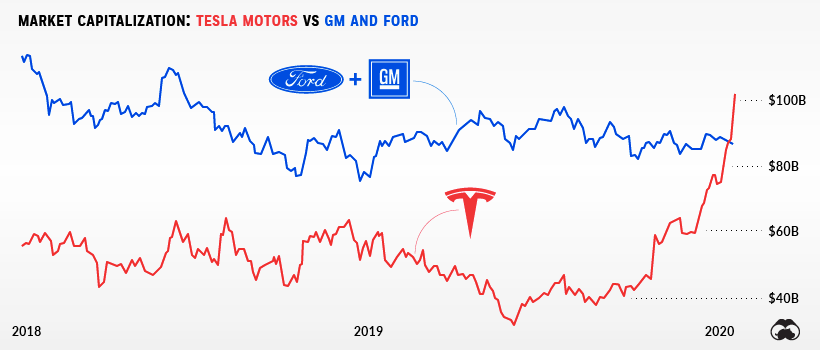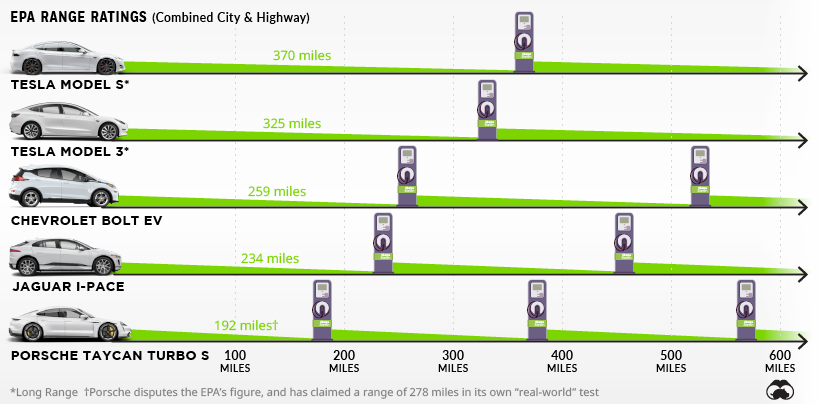The company is not only America’s most valuable automaker, it’s now worth more than Ford and GM combined.
Tesla’s valuation has already surpassed the $100 billion mark – a significant milestone for a company that produces a fraction of the vehicles of its direct competitors. Here’s a comparison of the top selling models in the U.S. for Ford, GM, and Tesla. A quick glance at this list is revealing. Though Tesla’s Model 3 put up strong sales numbers, it’s still only a small percentage of vehicles sold by U.S. automakers. So, what’s driving Tesla’s meteoric growth, and is it sustainable? Below, we’ll take a high-level look at the bull and bear cases for the company.
The Bull Case for Tesla Motors
Tesla posted losses of $1.1 billion in the first half of 2019, but since then, the company has turned the situation around in dramatic fashion. The automaker had a surprising third quarter with not only record deliveries of 97,000 cars, but also a profit of $143 million. Deliveries broke yet another record in Q4 2019, totaling 112,000 vehicles. These announcements helped improve market sentiment, sending the company’s stock back on an upward trajectory heading into 2020.
Here are three reasons some analysts and media are still bullish on Tesla:
1. Tapping into the World’s Largest Electric Car Market
For a long time, foreign companies looking to manufacture products in China couldn’t do so without working through a domestic partner. Recently though, Tesla became the first major benefactor of a policy change, becoming the first wholly foreign-owned automaker in China. Gigafactory 3 in Shanghai was completed in October, and was built in just 10 months – an impressive feat. Furthermore, cars have already begun rolling off the assembly lines, as Tesla targets an annual production of 150,000 Model 3s. Perhaps the best part for a company with historically volatile earnings: Tesla claims the facility was 65% cheaper to build than its production plant in the U.S.
2. Still the Range King
2019 saw many of the more established automakers take their first swings at Tesla. The United States Environmental Protection Agency (EPA) handed out official range ratings for several new electric cars, but none could unseat the king:
3. Musk’s Megaphone
Few CEOs capture the attention of media quite like Elon Musk. While his actions can sometimes have unintended consequences for the company – the infamous “funding secured” tweet, for example – Elon Musk’s massive reach allows the company to sell vehicles without spending a dime on advertising. By contrast, in 2018, Ford and GM spent $2.3 billion and $3.1 billion respectively on advertising in the U.S. alone.
The Bear Case for Tesla Motors
While the second half of 2019 has given Tesla bulls much to celebrate, many investors are remaining vigilant, if not skeptical.
1. Stiff Competition in China
Tapping into the world’s largest EV market is a double-edged sword for Tesla, as they face an onslaught of domestic and foreign competitors. The Chinese government has also generously supported its own EV industry, handing out over $60 billion in subsidies to over 400 companies. Tesla will be competing against state-owned enterprises like BAIC, one of the largest players in the Chinese EV market. Western automakers are also gaining a foothold in China as well. Volkswagen and its Chinese joint-venture partner, SAIC Motor, will begin producing cars at two factories in China in the autumn of 2020. The German automotive giant has also forged partnerships with Chinese battery manufacturers, including China’s biggest battery company Contemporary Amperex Technology (CATL).
2. Getting Ratio’d
Tesla has an extremely high premium on earnings when compared with its more established counterparts in the auto industry. The enterprise multiple (EV/EBITDA) measures the dollars in enterprise value for each dollar of earnings. The ratio is commonly used to determine if a company is undervalued or overvalued compared to peers.
The Bottom Line is… the Bottom Line
Of course, Tesla’s future will be dictated by variables more complex than can be summed up in a tidy pro/con list. Musk has shown a willingness to sacrifice profitability in the name of growth – Tesla has yet to prove it can deliver consistent, quarterly profits. – Elon Musk After reporting a record number of deliveries in the final quarter of 2019, there’s no doubt that true believers and short sellers alike will be watching the company’s January 29, 2020, earnings call with much anticipation. on But fast forward to the end of last week, and SVB was shuttered by regulators after a panic-induced bank run. So, how exactly did this happen? We dig in below.
Road to a Bank Run
SVB and its customers generally thrived during the low interest rate era, but as rates rose, SVB found itself more exposed to risk than a typical bank. Even so, at the end of 2022, the bank’s balance sheet showed no cause for alarm.
As well, the bank was viewed positively in a number of places. Most Wall Street analyst ratings were overwhelmingly positive on the bank’s stock, and Forbes had just added the bank to its Financial All-Stars list. Outward signs of trouble emerged on Wednesday, March 8th, when SVB surprised investors with news that the bank needed to raise more than $2 billion to shore up its balance sheet. The reaction from prominent venture capitalists was not positive, with Coatue Management, Union Square Ventures, and Peter Thiel’s Founders Fund moving to limit exposure to the 40-year-old bank. The influence of these firms is believed to have added fuel to the fire, and a bank run ensued. Also influencing decision making was the fact that SVB had the highest percentage of uninsured domestic deposits of all big banks. These totaled nearly $152 billion, or about 97% of all deposits. By the end of the day, customers had tried to withdraw $42 billion in deposits.
What Triggered the SVB Collapse?
While the collapse of SVB took place over the course of 44 hours, its roots trace back to the early pandemic years. In 2021, U.S. venture capital-backed companies raised a record $330 billion—double the amount seen in 2020. At the time, interest rates were at rock-bottom levels to help buoy the economy. Matt Levine sums up the situation well: “When interest rates are low everywhere, a dollar in 20 years is about as good as a dollar today, so a startup whose business model is “we will lose money for a decade building artificial intelligence, and then rake in lots of money in the far future” sounds pretty good. When interest rates are higher, a dollar today is better than a dollar tomorrow, so investors want cash flows. When interest rates were low for a long time, and suddenly become high, all the money that was rushing to your customers is suddenly cut off.” Source: Pitchbook Why is this important? During this time, SVB received billions of dollars from these venture-backed clients. In one year alone, their deposits increased 100%. They took these funds and invested them in longer-term bonds. As a result, this created a dangerous trap as the company expected rates would remain low. During this time, SVB invested in bonds at the top of the market. As interest rates rose higher and bond prices declined, SVB started taking major losses on their long-term bond holdings.
Losses Fueling a Liquidity Crunch
When SVB reported its fourth quarter results in early 2023, Moody’s Investor Service, a credit rating agency took notice. In early March, it said that SVB was at high risk for a downgrade due to its significant unrealized losses. In response, SVB looked to sell $2 billion of its investments at a loss to help boost liquidity for its struggling balance sheet. Soon, more hedge funds and venture investors realized SVB could be on thin ice. Depositors withdrew funds in droves, spurring a liquidity squeeze and prompting California regulators and the FDIC to step in and shut down the bank.
What Happens Now?
While much of SVB’s activity was focused on the tech sector, the bank’s shocking collapse has rattled a financial sector that is already on edge.
The four biggest U.S. banks lost a combined $52 billion the day before the SVB collapse. On Friday, other banking stocks saw double-digit drops, including Signature Bank (-23%), First Republic (-15%), and Silvergate Capital (-11%).
Source: Morningstar Direct. *Represents March 9 data, trading halted on March 10.
When the dust settles, it’s hard to predict the ripple effects that will emerge from this dramatic event. For investors, the Secretary of the Treasury Janet Yellen announced confidence in the banking system remaining resilient, noting that regulators have the proper tools in response to the issue.
But others have seen trouble brewing as far back as 2020 (or earlier) when commercial banking assets were skyrocketing and banks were buying bonds when rates were low.

















